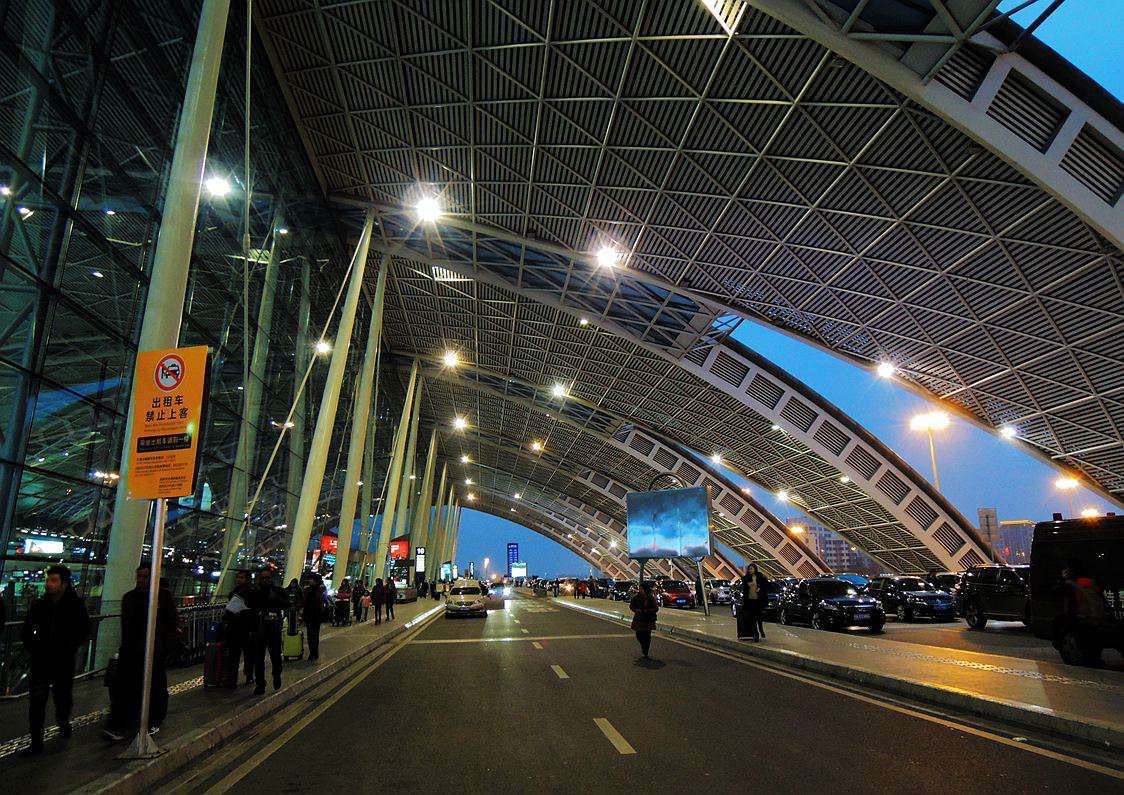Summary of Chongqing tours:
Chongqing, one of China’s four direct-controlled municipalities, is rich in history, culture, and business. At the confluence of the Yangtze and Jialing Rivers, Chongqing is known as the “Mountain City” for its mountainous terrain and beautiful scenery. Chongqing, a bustling metropolis with over 30 million residents, is a gateway to southwestern China’s magnificent scenery.
Chongqing has been a cultural and economic powerhouse for over 3,000 years. The city was China’s provisional capital during World War II and represents resilience and growth. Ancient traditions and modern innovations coexist in Chongqing today.
Visitor’s first impression of Chongqing is its unusual terrain. Built on hills and surrounded by mountains, the city has magnificent vistas and a unique layout. Hilly topography and many bridges distinguish Chongqing, which is often compared to San Francisco. The Yangtze River, Asia’s longest river, enhances the city’s splendor and offers river excursions to see the region’s stunning scenery.
Another draw of Chongqing is its climate. The city has hot, humid summers that top 35°C (95°F). Chongqing is known as “one of the Three Furnaces” of China due to its heat and humidity. It attracts travelers year-round because to warm winters, spring, and autumn.

Cultural heritage is one of Chongqing’s main draws. Numerous historical sites, ancient villages, and cultural icons in the city reveal China’s rich history. From the well-preserved Ciqikou Ancient Town to the stunning Dazu Rock Carvings, Chongqing offers a wealth of history and culture. The Three Gorges Museum and other city museums highlight the region’s history, culture, and natural surroundings.
Visitors could enjoy Chongqing’s famous hot pot, which is part of its dynamic culinary scene. Local cuisine relies on this spicy dish, which embodies the city’s boldness. The hot pot experience is a social feast for friends and family. In addition to hot pot, Chongqing has several tasty native snacks and cuisines.
Modern attractions in the city include spectacular architecture and cutting-edge facilities. The Chongqing Grand Theatre and Science and Technology Museum demonstrate the city’s devotion to heritage and innovation. Skyscrapers and modern buildings indicate Chongqing’s rapid development and economic importance.
Naturalists may easily visit China’s most stunning sights from Chongqing. Yangtze River cruises through the Three Gorges provide breathtaking views of the river’s towering cliffs and lush surroundings. Wulong Karst National Geology Park, a UNESCO World Heritage site nearby, with spectacular karst structures and natural bridges that demonstrate the region’s geological variety.
Chongqing is a metropolis of progress and innovation as well as history and environment. Chongqing, one of China’s fastest-growing cities, attracts international industries and investments. Visitors can easily travel the city thanks to its huge metro system and modern airports.
From historical landmarks to gastronomic pleasures, natural beauty, and modern attractions, Chongqing offers a rich and diversified tourist experience. This guide covers what to see, where to go, and how to maximize your visit to this intriguing city. This article offers practical travel advice and in-depth examination of significant sights to help you plan a memorable Chongqing vacation.
1. Getting to Chongqing

By Air
Air travel connects Chongqing to major Chinese and international cities, making it convenient for domestic and international passengers. The main Chongqing airport is Chongqing Jiangbei International Airport (CKG), 20 kilometers north of the city center. Over 40 million travelers pass through this contemporary airport, which has duty-free shops, cafés, and lounges.
Many major airlines fly directly to Chongqing from Beijing, Shanghai, Guangzhou, and Hong Kong. Direct flights from Tokyo, Seoul, Bangkok, Dubai, and Frankfurt are available to international passengers. Compare costs and schedules among airlines and book early, especially during high travel seasons like Chinese New Year and National Day.
The Chongqing Jiangbei International Airport is easy to navigate. Take a taxi or Airport Express bus to the city center upon arrival. The Chongqing Metro Line 3 connects the airport to numerous city areas, making public travel convenient and affordable.
By Train
Chongqing’s railway network is essential to its transportation infrastructure, providing fast and pleasant travel. The city has multiple significant railway stations, with Chongqing North and West being the main high-speed hubs.
Chongqing is connected to Beijing, Shanghai, Guangzhou, Chengdu, and Xi’an by high-speed rail. The high-speed train from Chongqing to Chengdu takes 1.5–2 hours, making it a good day excursion. Traveling from Shanghai to Chongqing takes 10 hours and is scenic and enjoyable.
You can order train tickets on China Railway’s 12306.cn or through English-speaking travel firms and apps. Booking tickets in advance is advised for popular routes and busy travel times. Arrive early at the train station to pass security and find your platform.
By Bus/Car
A bus or vehicle trip to Chongqing can be scenic and thrilling for road trippers. Far-reaching buses connect Chongqing to numerous nearby cities and regions. Chongqing Caiyuanba and Sigongli bus stations serve Chengdu, Guiyang, and Kunming often.
While bus travel is cheaper than flying or using the train, it can be less comfortable, especially for lengthy trips. Some overnight buses have sleepers and basic amenities. Bus terminals and internet ticketing systems sell tickets.
You can rent a car if you like driving. Chongqing’s major car rental businesses provide a variety of vehicles. Rental cars require a driver’s license and an International Driving Permit. Chongqing is 4-5 hours from Chengdu and offers stunning scenery and countryside exploration. Make sure your GPS system works and be ready for toll roads and traffic.
2. Top Chongqing Attractions
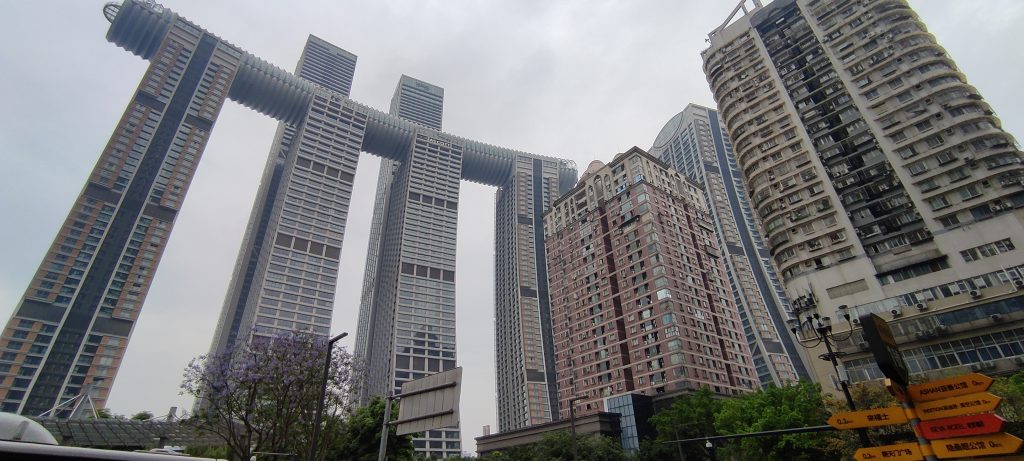
Jiefangbei CBD
The busy Jiefangbei CBD of Chongqing is sometimes compared to Times Square in New York City. The tall Jiefangbei Monument celebrates the War of Resistance triumph over Japan in this bustling neighborhood. The monument is flanked by shopping malls, high-end boutiques, worldwide brand stores, and local shops, making it a shopping heaven.
Jiefangbei has luxury restaurants and street food stalls in addition to shopping. Chongqing hot pot, spicy noodles, and grilled skewers are local specialties. Nightlife is extremely popular in the neighborhood, with several restaurants, clubs, and entertainment places where you can relax.
Jiefangbei CBD has many museums and galleries for history buffs. The neighboring People’s Liberation Monument gives historical context, while the Chongqing Art Gallery displays current Chinese art. Jiefangbei’s mix of modern and traditional architecture reflects Chongqing’s energy.
Hongya Cave

One of Chongqing’s most attractive attractions is Hongya Cave (Hongyadong), with its stilt dwellings erected along the high cliffs overlooking the Jialing River. This 11-story structure shows Chongqing’s distinctive architecture and lively city life.
The maze-like edifice houses shops, restaurants, and entertainment venues. Lower levels sell local goods and souvenirs, including handmade items, traditional apparel, and distinctive trinkets. Numerous restaurants serving local and international cuisines await you as you ascend. Evenings with the complex lit up with bright lights are great for riverside dining.
Hongya Cave is known for its nightlife. Locals and tourists frequent its bars and clubs for live music and a lively environment. Hongya Cave is best seen at night when the lights create a lovely atmosphere and the cityscape is breathtaking.
Ancient Ciqikou Town

Visitors can travel back in time to the Ming and Qing Dynasties in Ciqikou Ancient Town. This old town on the Jialing River has small, winding lanes with traditional buildings, teahouses, and stores.
Walking around Ciqikou, you’ll see several sellers offering local treats. Try the famous Ma Hua (fried dough twist) and Chen Mahua (sticky rice cake). Many shops sell homemade, antique, and traditional apparel in the village, making it a great souvenir spot.
Ciqikou’s many teahouses offer authentic Chinese tea culture. Folk music and opera are often performed in teahouses, creating an immersive cultural experience. Many historic temples in the town, including as the Baolun Temple, offer calm retreats and an insight into its spiritual legacy.
Museum of Three Gorges

History and culture buffs should visit the Three Gorges Museum near People’s Square. This modern museum covers Three Gorges and Chongqing history, culture, and environment.
The museum showcases Three Gorges Dam history, ancient antiquities, and Yangtze River nature. A comprehensive dam model, ancient pottery and bronze, and informative displays on local flora and fauna are highlights.
Multimedia exhibits include a 360-degree film that immerses visitors in the Three Gorges. The Three Gorges Museum explains the region’s importance and how the dam project affected the ecosystem and communities.
3. Natural Wonders
Yangtze River Cruise
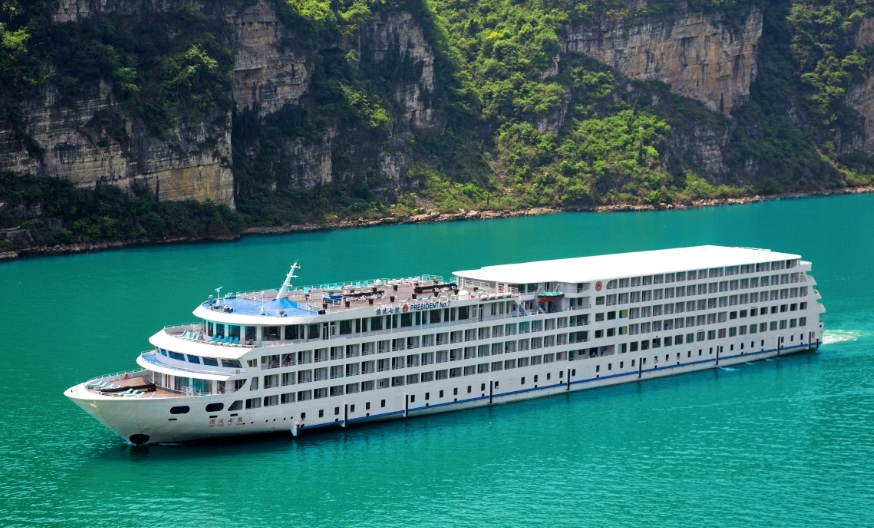
One of the best methods to see Chongqing’s natural beauty is by Yangtze River cruise. These cruises give a unique view of the Yangtze River’s beautiful scenery and historical monuments, including the Three Gorges.
Several cruise operators provide multi-day luxury cruises with high-end amenities and budget-friendly day activities. The three- to four-day downstream trek from Chongqing to Yichang is the most popular. This path passes through the Qutang, Wu, and Xiling Gorges, with towering cliffs, green hillsides, and foggy streams.
The ship offers luxury rooms, excellent cuisine, and entertainment like traditional Chinese plays and cultural lectures. Shore trips to Fengdu Ghost City and Shibaozhai Pagoda reveal the region’s rich history.
Wulong Karst National Geopark

UNESCO World Heritage site Wulong Karst National Geology Park is 130 kilometers from Chongqing. The park’s limestone cliffs, steep gorges, and enormous underground caves are famed.
The Three Natural Bridges are a park highlight. Three enormous stone arch bridges span a deep, lush gorge at this stunning spot. Walkways and viewing platforms give stunning views of the bridges and surrounding surroundings.
Furong Cave, China’s largest and most magnificent, is another highlight. The cave’s complex stalactites, stalagmites, and other rock formations are enhanced by colored illumination. These natural wonders’ geological formations are explained on tours.
Wulong Karst offers hiking, rock climbing, and zip-lining for adventurers. The park’s unique geology and scenery
4. Cultural Adventures
Hot Pot Dining
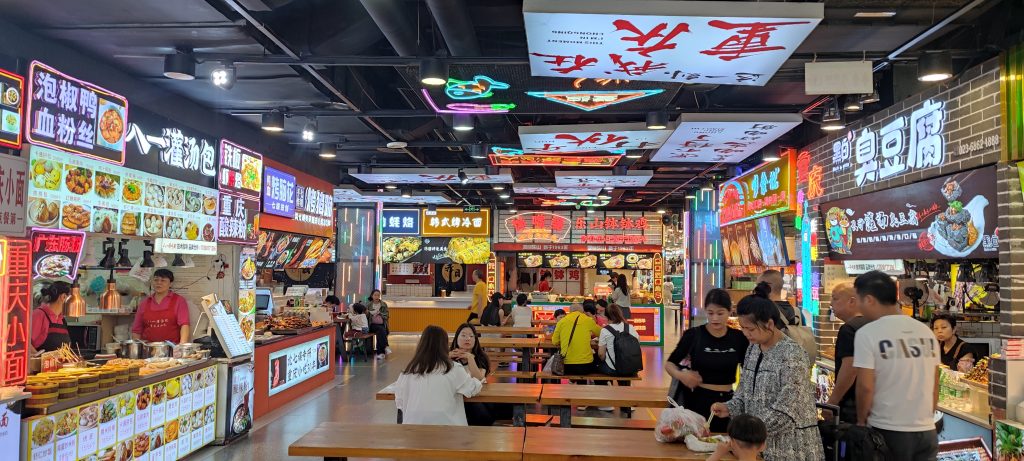
Hot pots, a communal supper that showcases Chongqing’s rich cuisine culture, are famous. This traditional meal includes preparing a variety of items in a simmering pot of soup, usually separated into hot and mild sides to suit varied tastes.
Chongqing hot pot originated over a century ago when dockworkers and boatmen utilized spicy broths to cover the stench of inferior meat. Hot pots now draw foodies from across the globe. Dip thinly sliced meats, fresh vegetables, tofu, and noodles into the simmering soup and serve them with dipping sauces for a tasty and participatory meal.
Famous Chongqing hot pot restaurants like Hai Di Lao and Xiao Tian E use high-quality ingredients and provide excellent service. Hai Di Lao is known for its unique touches, like as free appetizers, manicure treatments while you wait, and tableside noodle dancers. Xiao Tian E’s rustic environment takes you back in time as you enjoy genuine Chongqing hot pot.
Traditional Shows

Visitors may experience local culture at Chongqing’s many traditional performances. Sichuan opera, with its face-changing (bian lian) method, is intriguing. This captivating performance has performers changing masks instantly, giving a feeling of enchantment and amazement.
The Chongqing Theatre and Huguang Guild Hall are great Sichuan opera venues. These shows sometimes feature fire-spitting, acrobatics, and traditional Chinese music for a complete cultural experience. Although the operas are primarily performed in Mandarin, the visuals and music make them pleasant for non-Chinese speakers.
Chongqing also offers folk music and dance performances during festivals and local events. These performances include inherited instruments, costumes, and dances. The Dragon Boat Festival and Chongqing International Culture and Tourism Festival provide a unique chance to experience these traditional traditions.
5. Modern Attractions
Chongqing Grand Theatre
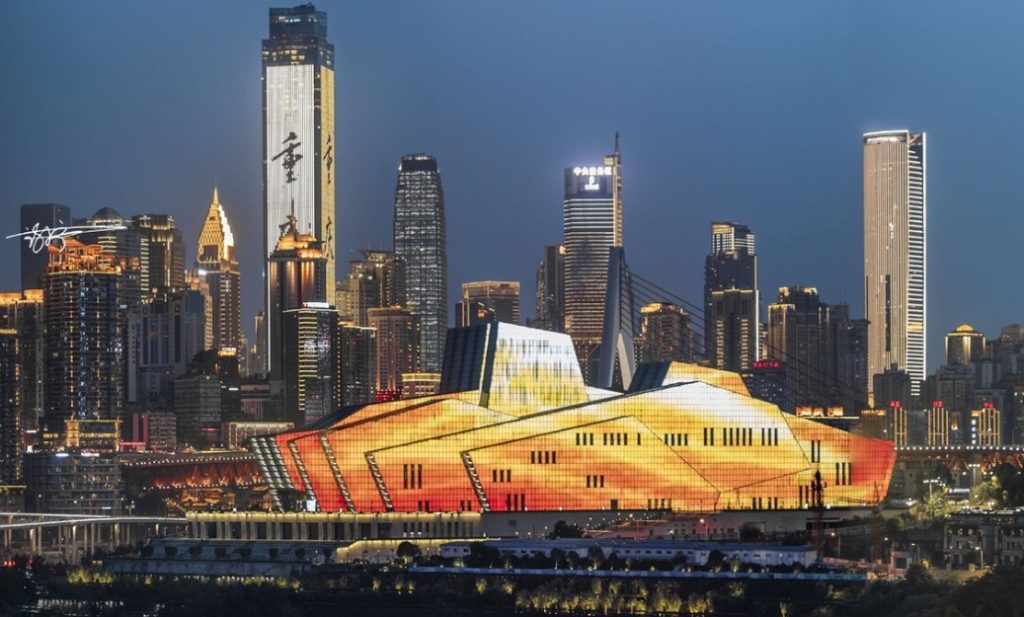
The Yangtze River-side Chongqing Grand Theatre is a beautiful building. Its futuristic, wave-like architecture reflects the Yangtze and Jialing Rivers’ junction, making it a municipal landmark. The theater is a cultural hub, featuring opera, ballet, concerts, and plays.
World-class acoustics and comfortable seats enhance high-quality performances. The theater hosts traditional Chinese and foreign performances, giving a varied cultural palette. In addition to seeing a play, guided tours of the theater reveal its design and production technologies.
SciTech Museum, Chongqing

The Chongqing scientific and Technology Museum attracts families and scientific enthusiasts. Interactive displays and hands-on activities make learning enjoyable at this Jiangbei District museum. The museum encompasses space exploration, robotics, environmental science, and human biology.
Each museum area is instructive and fun, with lots of exhibit interaction. A 4D theater, a planetarium with immersive cosmic displays, and many scientific demonstrations delight all ages. The hands-on activities and interactive exhibits make the museum a great spot to spend a few hours with kids.
Nanshan Botanical Garden
Nanshan Botanical Garden on Nanshan Mountain is ideal for a calm getaway. The large garden contains uncommon and unusual flora. The rose garden, bonsai garden, and bamboo forest are among the themed portions with distinct charm.
The botanical garden’s Nanshan Pine Tree Forest and lake are popular for leisure and photography. The mountaintop vista of Chongqing from Nanshan Botanical Garden is a highlight. On clear days, you can view the enormous metropolis and the meandering Yangtze River below, making it perfect for a picnic or stroll.
6. Day Trips from Chongqing
National Forest Fairy Mountain

Fairy Mountain National Forest Park, 200 kilometers from Chongqing, is a paradise for outdoor enthusiasts. The park is known for its lush woods, undulating meadows, and stunning vistas that give a break from city life.
Visitor activities include hiking, horseback riding, and camping. The park’s well-marked paths provide simple and difficult treks for all fitness levels. Snowy Fairy Mountain attracts skiers, snowboarders, and other winter sports enthusiasts.
Fairy Cave, a limestone cave with spectacular stalactites and stalagmites, and Fairy Lake, a boating and picnicking spot, are included in the park. Fairy Mountain is a great day excursion from Chongqing due to its tranquility and beauty.
Valley Heishan

Heishan Valley, commonly called as Black Mountain Valley, is 130 kilometers from Chongqing and famed for its stunning cliffs, rich greenery, and clear streams. Hiking routes around the valley give stunning views of waterfalls, rock formations, and deep woods at this natural treasure.
The Heishan Valley glass skywalk, which spans a cliff, is an exciting attraction with stunning views of the valley below. Adventurers may rock climb, zip-line, and float in the valley. Photographers and wildlife enthusiasts will adore the area’s many picture possibilities.
Shibaozhai
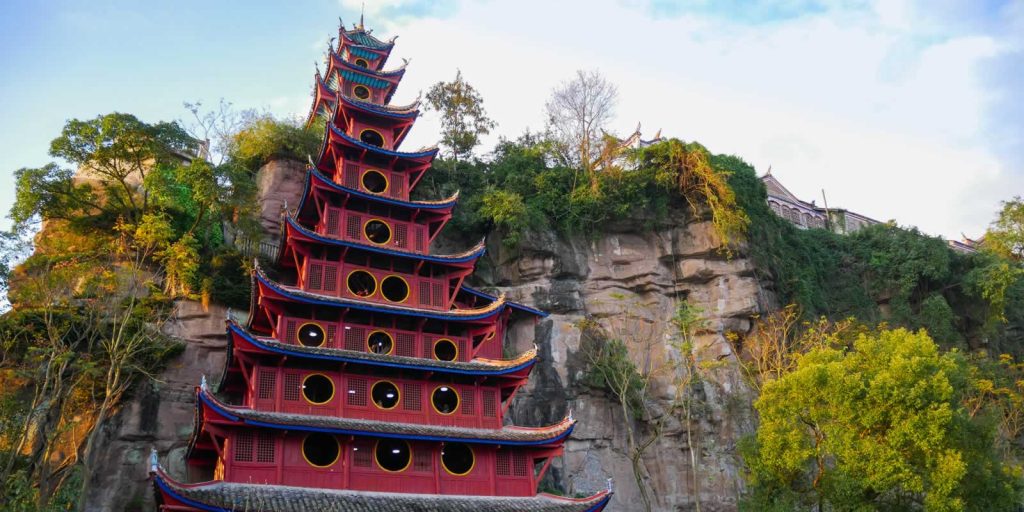
Shibaozhai, an ancient temple complex 170 kilometers from Chongqing, is known for its nine-story crimson pagoda erected without nails. On a high cliff overlooking the Yangtze River, the pagoda and temple at its peak give breathtaking views of the river and surroundings.
Each story of the pagoda has shrines and sculptures of Buddhist deities, making climbing the short wooden steps interesting. Shibaozhai is full with stories and folklore from the Ming Dynasty. Shibaozhai is a wonderful combination of natural beauty and historical importance, with guided tours of the temple.
7. Good to know about Chongqing tours
Best Visit Times
Hot summers and mild winters characterize Chongqing’s humid subtropical climate. Spring (March–May) and fall (September–November) are the best months to visit for sightseeing due to good weather. City parks and natural attractions are at their best during these seasons of mild temperatures.
Spring in Chongqing is great for outdoor activities and sightseeing due to blossoming flowers and greenery. Autumn’s lower weather and beautiful foliage make for a gorgeous travel background. Hot and humid summers might surpass 35°C (95°F), making outdoor exploration unpleasant. Winters are moderate with intermittent rain, making them ideal for indoor attractions and city cuisine.
Transportation in Chongqing
Chongqing’s extensive public transit makes getting around easier. With many lines serving significant metropolitan districts, the Chongqing Metro is the most efficient method to commute. Clean, safe, and inexpensive, the metro has Chinese and English signage and announcements.
Buses reach locations not covered by the metro and are another handy alternative. Taxis are cheap and plentiful, but write your destination in Chinese to prevent confusion. Ride-hailing applications like Didi Chuxing are popular and handy for those who desire flexible transportation.
Though Chongqing is mountainous, walking is an excellent way to see its districts. Due to the city’s terrain, many streets have steep inclines, so wear comfortable shoes.
Accommodation
Chongqing has accommodations for various tastes and budgets. The city has several hotels and hostels, from luxury to affordable. The JW Marriott Hotel Chongqing and InterContinental Chongqing Raffles City provide elegant stays with magnificent views, great facilities, and accessible locations.
Holiday Inn and local boutique hotels provide affordable, pleasant lodgings. Hostels and guesthouses like the Chongqing Wulong Furong Cave International Youth Hostel provide clean, cheap accommodations in a pleasant setting.
Choose accommodations based on accessibility to main attractions, public transportation, and amenities like free Wi-Fi and breakfast. Jiefangbei and Nanbin Road are near several of the city’s prominent attractions and restaurants.
Safety and Health Tips
Low crime and a pleasant attitude make Chongqing a safe tourism destination. However, it’s important to watch your things, avoid poorly lit locations at night, and use ATMs carefully.
Drinking tap water in Chongqing is not advised; use bottled or heated water. Use a reusable water bottle with a filter to remain hydrated and reduce plastic waste. To prevent health risks, prepare food properly while eating out, particularly at street food booths.
In July, Chongqing’s hot and humid atmosphere may cause heat exhaustion. Stay hydrated, wear lightweight, breathable clothes, and take pauses in air-conditioned areas to prevent overheating. Wearing a hat and sunscreen may also protect you from the sun.
Planning early and considering these practical factors can guarantee a safe, pleasurable, and memorable vacation to Chongqing, a city that mixes ancient history with current energy and natural beauty.




